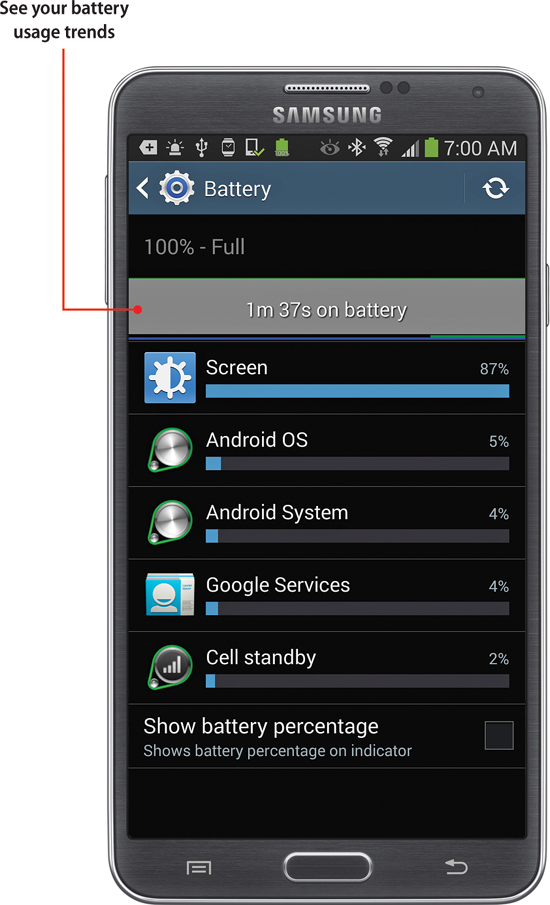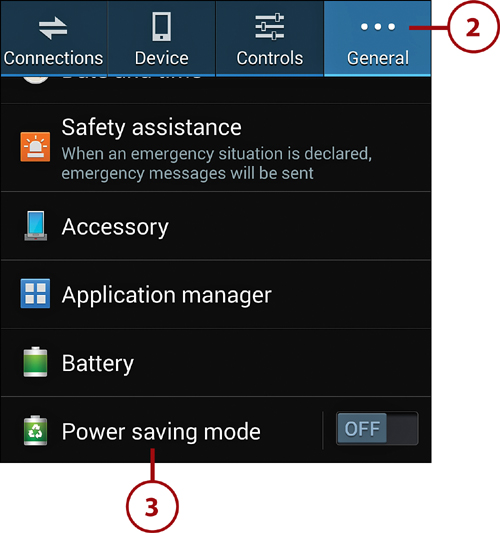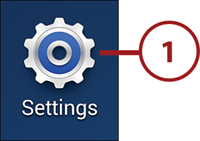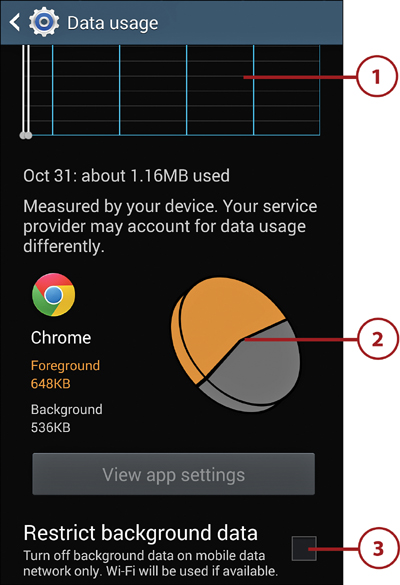13. Maintaining Your Galaxy Note 3 and Solving Problems

In this chapter, you discover how to maintain your Galaxy Note 3 and solve problems. Topics include the following:
→ Updating Android
→ Optimizing battery life
→ Identifying battery-hungry apps
→ Caring for your Galaxy Note 3
Every so often, Google releases new versions of Android that include bug fixes and new features. In this chapter, you find out how to upgrade your Galaxy Note 3 to a new version of Android and how to tackle common problem-solving issues and general maintenance of your Galaxy Note 3.
Updating Android
New releases of Android are always exciting because they add new features, fix bugs, and tweak the user interface. Here is how to update your Galaxy Note 3.
Updates to Android are not on a set schedule. The update messages appear as you turn on your Galaxy Note 3, and they remain in the Notification bar until you install the update. If you touch Install Later, your Note 3 reminds you at short intervals—30 minutes, 1 hour, or 3 hours—that there’s an update. When to install the update is up to you. You might prefer to wait to see if each new update contains any bugs that need to be worked out rather than applying each update immediately.
1. Pull down the Notification bar to open the Notification shade.
Manually Checking for Updates
If you think there should be an update for your Galaxy Note 3 but have not yet received the onscreen notification, you can check manually by touching Settings, General, About Device, and Software Update. On the Software Update screen, touch Update to check for an update.
2. Touch Software Update to display the Software Update screen.


3. Touch Install.

4. Touch OK in the next Software Update dialog, which tells you that the device will be rebooted. Your Galaxy Note 3 restarts, installs the update, and then displays the Lock screen.

5. Unlock the Galaxy Note 3 as usual. For example, swipe the screen and then type your passcode. A Software Update dialog opens, confirming that the device has been updated successfully.
6. Touch OK to close the dialog. You can then resume using your Galaxy Note 3 normally.


Delaying an Update
If you do not want to install the software update immediately, touch Later on the Software Update screen. In the Reminder Interval dialog that appears, touch 30 Minutes, 1 Hour, or 3 Hours, as appropriate.
Optimizing the Battery
The battery in your Galaxy Note 3 is a lithium-ion battery that provides good battery life as long as you take care of it. You can change the way you use your Galaxy Note 3 to prolong the battery life so that the battery lasts long enough for you to use the phone all day.
Carrying a Spare Battery
One of the great things about the Galaxy Note 3 is how easily you can remove the back and change the battery. Given this feature, you might prefer to buy and carry a spare battery instead of scrimping on display brightness and phone usage. When your current battery runs out, you can power off the Note 3, pop in the spare battery, and restart it in less than a minute.
Take Care of the Battery
There are specific steps you can take to take care of the battery in your Galaxy Note 3 and make it last longer.
Follow these steps to care for your Galaxy Note 3’s battery:
1. Try to avoid discharging the battery completely. Fully discharging the battery too frequently harms the battery. Instead, try to keep it at least partially charged at all times (except as described in the next step).
2. To avoid a false battery level indication on your Galaxy Note 3, let the battery fully discharge about every 30 charges. Lithium-ion batteries do not have “memory” like older battery technologies, but fully discharging the battery once in a while helps keep the battery meter working correctly.
3. Avoid letting your Galaxy Note 3 get overheated because this can damage the battery and make it lose charge quickly. Do not leave your Note 3 in a hot car or out in the sun anywhere, including on the beach.
4. Consider having multiple chargers. For example, you could have one at home, one at work, and one in your car. This enables you to always keep your phone charged.
Monitor Battery Use
Android enables you to see exactly what apps and system processes are using the battery on your Galaxy Note 3. Armed with this information, you can alter your usage patterns to extend the Galaxy Note 3’s runtime on the battery.
1. On the Apps screen, touch Settings.

2. Touch the General tab.
3. Touch Battery to display the Battery screen.

4. Touch to manually refresh the display.
5. Touch an app or Android service to see more details about it, including how much time it has been active, how much processor (CPU) time it has used, and—if the app has used data—how much data it has sent and received.
6. Touch the battery charge and usage diagram to display the History Details screen, which contains more details on the power consumption.

7. Look at the Mobile Network Signal readout to see when the mobile network signal was being used during the battery graph’s time span.
8. Look at the GPS On readout to determine when the GPS radio was being used during the battery graph’s time span.
9. Look at the Wi-Fi readout to see when the Wi-Fi radio was being used during the battery graph’s time span.
10. Look at the Awake readout to learn when your Galaxy Note 3 was awake during the battery graph’s time span.
11. Look at the Screen On readout to check when your Galaxy Note 3’s screen was on during the battery graph’s time span.
12. Look at the Charging readout to find out when your Galaxy Note 3 was charging (if at all) during the battery graph’s time span.

How Can Seeing Battery Drain Help?
If you look at the way your battery has been draining, you can see when the battery was draining the fastest, and you should be able to remember what apps you were using at that time or what you were doing on your Galaxy Note 3. Based on that, you can change your usage habits—for example, you can plan to charge your Galaxy Note 3 after a session of phone calls. You can uninstall any apps that appear to be power hogs, or you can simply avoid using them when running on the battery.
Choose Power-Saving Options
Your Galaxy Note 3 includes a feature called Power Saving Mode that enables you to reduce the amount of power it consumes. After choosing which of three power-saving options to use, you can turn Power Saving on and off by using its switch on the Settings screen.
1. Touch Settings on the Apps screen.

2. Touch the General tab.
3. Touch the main part of the Power Saving button—anywhere apart from the switch—to display the Power Saving Mode screen.

4. Move the Power Saving Mode switch to On to make the settings available.
5. Check CPU Power Saving to enable throttling back the processor when the Galaxy Note 3 is running on battery power.
6. Check Screen Power Saving to enable reducing the screen’s brightness on the battery.
7. Check Turn Off Haptic Feedback to enable turning off vibration when you touch the screen.
8. Touch Learn About Power Saving to see tips on saving power.
9. Touch to return to the Settings screen, where you can turn Power Saving Mode on and off by moving the Power Saving Mode switch. This switch has the same effect as the switch on the Power Saving Mode screen; it is simply easier to access.

Turning Power Saving Mode On and Off Quickly
When you need to squeeze the most runtime out of your Galaxy Note 3’s battery, you’ll probably want to turn Power Saving Mode on and off at a moment’s notice. To do so, pull down from the top of the screen to display the Notifications panel, touch the Quick Settings button, and then touch the Power Saving icon.

Apps and Memory
Each app you run on your Galaxy Note 3 has to share the phone’s memory. Although Android usually does a good job of managing this memory, sometimes you have to step in to close an app that has grown too large.
1. On the Apps screen, touch Settings to open the Settings app.

3. Touch Application Manager to display the Application Manager screen.

4. Swipe left one or more times as needed to display the Running tab. This tab lists the apps that are currently running.
5. The graph shows how much memory is being used by running apps and cached processes, and how much is free.
6. Touch an app to see more information about it.

7. Touch Stop if you believe the app is misbehaving.
8. Touch to report an app to Google. You might want to do this if it is misbehaving, using up too many resources, or you suspect it of stealing data. Some apps disable the Report button to prevent reporting, as in the example.
9. Look at this readout to see the processes that are being used by this app.


When Should You Manually Stop an App?
After you have been using your Galaxy Note 3 for a while, you’ll become familiar with how long it takes to do certain tasks, such as typing, navigating menus, and so on. If you notice your phone becoming slow or not behaving the way you think it should, the culprit could be a new app you recently installed. Because Android never quits an app on its own, that new app continues running in the background, which might cause your Galaxy Note 3 to slow down. When this happens, it is useful to manually stop an app. If stopping one or more apps doesn’t help, try restarting your Galaxy Note 3.
Reining in Your Data Usage
If you are worried that you might exceed your data plan in a month, you can set a usage limit on your Galaxy Note 3. You can even prevent apps from using data while they are running in the background rather than in the foreground.
1. On the Apps screen, touch Settings to open the Settings app.

2. Touch Connections to display the Connections screen.
3. Touch Data Usage to display the Data Usage screen.

4. Make sure Mobile Data is checked to enable data transfer over your Galaxy Note 3’s cellular connection.
5. Touch to enable or disable mobile data limits. When this is enabled, your Galaxy Note 3 automatically cuts off all mobile data usage when the limit you set in step 7 is reached.
6. Touch to set the monthly billing cycle your cellular carrier uses for your Galaxy Note 3’s account.
7. Touch the red handle and drag the red line up or down to select the mobile data limit you want to impose. This might or might not match your cellular data plan limit.
8. Touch the orange handle and drag the orange line up and down to set a data usage warning threshold. When you reach or pass this threshold, you see a warning in the Notification bar.

9. Scroll down if necessary, and touch an app to see more details about its data usage and to control how it uses data in the background.

Set Background Data Limits
When you touch an app to see its data usage, you can also limit its usage when it is in the background. An app is in the background when you have launched the app but you are not currently using it. An app in the background still takes up memory and might still be transferring data.
1. Look at the Data Usage chart to see the data usage for this app specifically.
2. Look at the pie chart to see the breakdown of data usage in the foreground and background.
3. Touch to restrict the app from using data while it is in the background.

Caring for the Galaxy Note 3’s Exterior
Because you need to touch your Galaxy Note 3’s screen to use it, it picks up oils and other residue from your hands. You also might get dirt on other parts of the phone. Here is how to clean your Galaxy Note 3 and how to avoid damaging its micro-USB port.
1. Wipe the screen with a microfiber cloth. You can purchase these in most electronic stores, or you can use the one that came with your sunglasses.
2. To clean dirt off other parts of your phone, wipe it with a damp cloth. Never use soap or chemicals on your Galaxy Note 3 as they can damage it.
3. When inserting the connector on the USB cable, try not to force it in the wrong way. If you damage the pins inside your Galaxy Note 3, you will need to take the battery out and use an external charger to charge it.
Protecting Your Galaxy Note 3’s Exterior
Another way to care for your Galaxy Note 3’s exterior is to protect it with a case. Many different types of cases are available from both brick-and-mortar stores and online stores. To protect the screen, you can apply a screen protector. When choosing a screen protector, make sure it is thin enough for the S Pen to work effectively.
Getting Help with Your Galaxy Note 3
There are many resources on the Internet where you can get help with your Galaxy Note 3.
1. Visit Samsung’s official Galaxy Note 3 and Galaxy Gear site at http://www.samsung.com/global/microsite/galaxynote3-gear/.
2. Visit Google’s official Android website at www.android.com.
3. Check out Android blogs such as these:
• Android Central at www.androidcentral.com/
• Android Guys at www.androidguys.com/
• Androinica at http://androinica.com/
